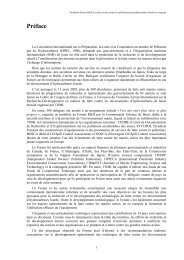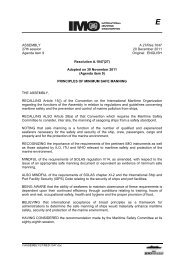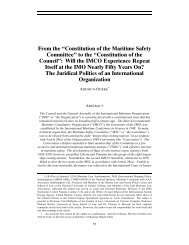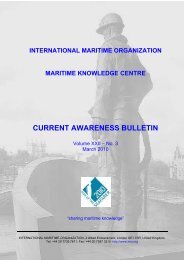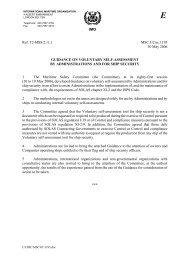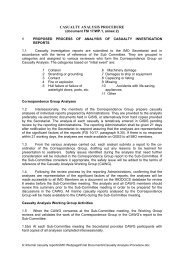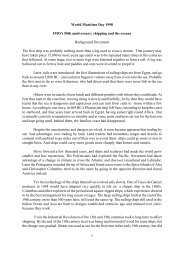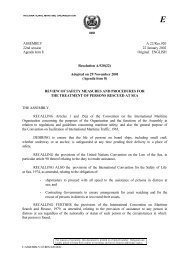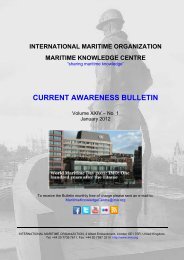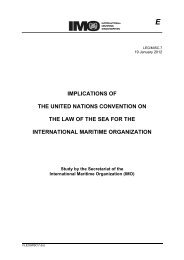Radioactive Waste Disposal at Sea: Public Ideas ... - IMO
Radioactive Waste Disposal at Sea: Public Ideas ... - IMO
Radioactive Waste Disposal at Sea: Public Ideas ... - IMO
You also want an ePaper? Increase the reach of your titles
YUMPU automatically turns print PDFs into web optimized ePapers that Google loves.
22 Chapter 2<br />
it enters the body, though generally less of a hazard than an alpha emitter.<br />
Gamma rays, a very high-energy form of radi<strong>at</strong>ion, penetr<strong>at</strong>e a rel<strong>at</strong>ively<br />
gre<strong>at</strong> thickness of m<strong>at</strong>ter, such as steel and concrete, before being absorbed.<br />
Overexposure of the body to gamma radi<strong>at</strong>ion results in deep-se<strong>at</strong>ed<br />
organic damage. Gamma radi<strong>at</strong>ion is by far the most serious external hazard<br />
of the three types of radi<strong>at</strong>ion from radioactive substances, and it<br />
requires heavy shielding and remotely controlled oper<strong>at</strong>ions.<br />
One curie (Ci) is defined as the amount of radioactive m<strong>at</strong>erial th<strong>at</strong> will<br />
produce 37 billion (3.7 × 10 10 ) disintegr<strong>at</strong>ions per second. This is approxim<strong>at</strong>ely<br />
the number of disintegr<strong>at</strong>ions per second in a gram of radium. A<br />
more recent unit is the becquerel (Bq), which is the amount of radioactive<br />
m<strong>at</strong>erial th<strong>at</strong> produces one disintegr<strong>at</strong>ion per second. One terabecquerel<br />
(TBq) is approxim<strong>at</strong>ely equal to 27 curies. Minute radi<strong>at</strong>ion is measured in<br />
nanocuries, one nanocurie being a billionth (10 –9 ) of a curie.<br />
The two basic options for managing radioactive wastes are (1) to concentr<strong>at</strong>e<br />
and then store them and (2) to dilute them and then disperse them<br />
in the environment. 2 Many forms of radioactive wastes exist, and all must<br />
ultim<strong>at</strong>ely be disposed of. <strong>Disposal</strong> signifies the final f<strong>at</strong>e of the waste without<br />
the intention of retrieval l<strong>at</strong>er; storage means a temporary scheme. 3<br />
<strong>Disposal</strong> does not imply continuous monitoring; storage does. Low-level<br />
radioactive waste, which also can be disposed of on land, is the only form<br />
of radioactive waste th<strong>at</strong> has been dumped in the oceans. 4 Most of this<br />
waste has been packaged in 55-gallon drums filled with concrete to ensure<br />
th<strong>at</strong> the drums would sink to the ocean bottom. These drums were not<br />
designed to remain intact for long periods on the sea bottom, and it was<br />
assumed th<strong>at</strong> the contents would be released almost instantly (Templeton<br />
1982, p. 39).<br />
Fallout from <strong>at</strong>mospheric testing of nuclear weapons, which also has<br />
reached the oceans, is regul<strong>at</strong>ed under the Limited Test Ban Tre<strong>at</strong>y. 5<br />
Volcanic eruptions on the sea bed, fallout from <strong>at</strong>mospheric nuclear<br />
weapons tests, the Chernobyl nuclear disaster, and oper<strong>at</strong>ional discharges<br />
from the British Sellafield nuclear reprocessing plant (previously known as<br />
Windscale) have been by far the gre<strong>at</strong>est contributors to the radioactivity<br />
of the marine environment. As the marine scientists Bewers and Garrett<br />
summarize (1987, p. 106): “The total amount of radioactivity dumped in<br />
the ocean, some 6 × 10 4 TBq, is much less than the approxim<strong>at</strong>ely 2 × 10 8<br />
TBq th<strong>at</strong> were added to the oceans as a result of <strong>at</strong>mospheric testing of




